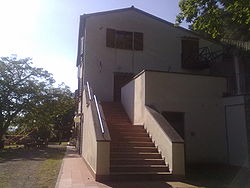- Museo del fiore
-
Museo del Fiore 
Established 1995 Location  Monte Rufeno natural reserve, Viterbo
Monte Rufeno natural reserve, ViterboType naturalistic The Museo del Fiore is a small naturalistic, multimedial and interactive museum, located in Italy, in the woods of the Monte Rufeno natural reserve which is 10 km far from Acquapendente (Viterbo) and 2 km from the characteristic medieval city of Torre Alfina. It has been realized in the inside of an old rural building, "Casale Giardino". With more than 1,000[1] species of known plants in its territories and rare animals, the Monte Rufeno natural reserve, at the border with Umbria and Tuscany, is an area with a large variety of flora and wildlife. The Museum was created thanks to the many blooms of the reserve and the deep link that flowers and plants have within the local culture, which is expressed with the Pugnaloni of Acquapendente (a big mosaic composed with petals and leaves inspired by the dream of freedom from the oppression, made in honor of Our Lady of the Flower, which is celebrated every year on the third Sunday of May).
Contents
Aims of the Museum
The museum aims to raise awareness of the environmental heritage of the area and function as an "archive" of biodiversity. The museum also offers activities and meetings with school and families that combine the discovery and knowledge of the natural world with the intention to conserve nature. Visiting the area is very easy: the flower trail is an easy loop route which takes the visitors to different stops, to the botanical garden and the picnic area. The museum also organizes summer camps.
Sections
The Museum of flowers dividied into several sections, each covering different themes and exploiting a variety of media: photos, illustrations, models, panels and tools. The museum is equipped with laboratories, a projection room, play room, to allow visitors to interact directly with nature and obsekre from different points of viero.
The World of flowers
In this section there are plastic reconstructions of flowers and insects. It aims help to discover the secrets of the flowers and to understand the importance of flowers and of nature. In this part of the Museum visitors cull also find out how pleants and flowers change over time and how they react to different habitats.
The flowers of the Natural Reserve
The centre of this section is a herbarium which contains over 300 specimens of dried plants represent the local flora. In addition, there is a plastic of the reserve showingits hiking trails and the old houses.
The evolution of plant forms and flowers
This section allows the visitors to understand deeply what a flower is and how it works, through a 3D reproduction of a cell and different flowers. Thanks to the "evolution tree", it's possible to understand the origin of the flowers, from primitive forms such as the magnolia to more complex ones, like the orchids.
Flowers and insects
This section tries to explain why the nature makes flowers so beautiful and smelling. The answer is simple: to attract insect which, unaware, move pollen from one plant to the next, allowing the plants to reproduce.
The ecological relations
Flowers are a key part of the life and are closely linked to other natural elements such as soil, water, rocks, wind animals, mushrooms,etc. The museum offers the opportunity to admire the beauty of nature thanks to its incredible exhibition of trees, soil and plants. Visitors can also learn the way bees live and interact in their social system enjoying a series of comprehensive panels on the large outdoor terrace. Children can listen to stories and legends of local populations.
The flowers and man
This section shows a great multimedia daisy whose petals are each a workstation. The workstation are multimedia archives which analyse the relationship between man and flowers in mythology, religion, folklore and history. The section ends with an insight of local celebration of Pugnaloni.
Curiosity shop
In this section everyone can smell the fragrances of many endangered plants. We can also discover the importance of conversation of endangered spacies, because many plants can surprise us with their flowers. In this room the clock of flowers marks the daily life of plants: some flowers open at night, others come to life at dawn.
Educational workshop and playroom
In the laboratory children and adults can have a close look at nature through microscopes, instruments and artefacts. The library is the place where young children learn to plat especially with their five sensec.
The flowers trail and outdoor spaces
Outdoor a long path guides the visitors to discovers the features of local plants and flowers. It is 3 kilometers long and full of informative panels. The path leads to the beautiful old mell, now restored. Finally, in the large garden surrounding the museum, a picnic area with tables can be found.
Gallery
References
External links
Categories:- Museums in Italy
Wikimedia Foundation. 2010.















